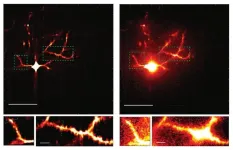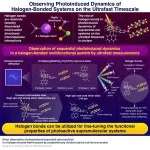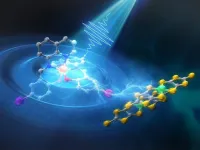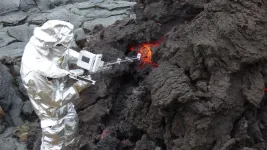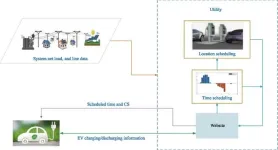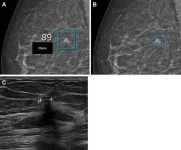(Press-News.org) The brain’s ability to learn comes from “plasticity,” in which neurons constantly edit and remodel the tiny connections called synapses that they make with other neurons to form circuits. To study plasticity, neuroscientists seek to track it at high resolution across whole cells, but plasticity doesn’t wait for slow microscopes to keep pace and brain tissue is notorious for scattering light and making images fuzzy. In a paper in Scientific Reports, a collaboration of MIT engineers and neuroscientists describes a new microscopy system designed for fast, clear, and frequent imaging of the living brain.
The system, called “multiline orthogonal scanning temporal focusing” (mosTF), works by scanning brain tissue with lines of light in perpendicular directions. As with other live brain imaging systems that rely on “two-photon microscopy,” this scanning light “excites” photon emission from brain cells that have been engineered to fluoresce when stimulated. The new system proved in the team’s tests to be eight times faster than a two-photon scope that goes point by point, and proved to have a four-fold better signal to background ratio (a measure of the resulting image clarity) than a two-photon system that just scans in one direction.
“Tracking rapid changes in circuit structure in the context of the living brain remains a challenge,” said co-author Elly Nedivi, William R. (1964) and Linda R. Young Professor of Neuroscience in The Picower Institute for Learning and Memory and MIT’s Departments of Biology and Brain and Cognitive Sciences. “While two-photon microscopy is the only method that allows high resolution visualization of synapses deep in scattering tissue, such as the brain, the required point by point scanning is mechanically slow. The mosTF system significantly reduces scan time without sacrificing resolution.”
Scanning a whole line of a sample is inherently faster than just scanning one point at a time, but it kicks up a lot of scattering. To manage that scattering, some scope systems just discard scattered photons as noise, but then they are lost, said lead author Yi Xue, an assistant professor at UC Davis and a former graduate student in the lab of corresponding author Peter T.C. So, professor of mechanical engineering and biological engineering at MIT. Newer single-line and the mosTF systems produce a stronger signal (thereby resolving smaller and fainter features of stimulated neurons) by algorithmically reassigning scattered photons back to their origin. In a two-dimensional image, that process is better accomplished by using the information produced by a two-dimensional, perpendicular-direction system such as mosTF, than by a one-dimensional, single-direction system, Xue said.
“Our excitation light is a line rather than a point—more like a light tube than a light bulb— but the reconstruction process can only reassign photons to the excitation line and cannot handle scattering within the line,” Xue explained. “Therefore, scattering correction is only performed along one dimension for a 2D image. To correct scattering in both dimensions, we need to scan the sample and correct scattering along the other dimension as well, resulting in an orthogonal scanning strategy.”
In the study the team tested their system head-to-head against a point-by-point scope (a two-photon laser scanning microscope – TPLSM) and a line-scanning temporal focusing microscope (lineTF). They imaged fluorescent beads through water and through a lipid-infused solution that better simulates the kind of scattering that arises in biological tissue. In the lipid solution, mosTF produced images with a 36-times better signal-to-background ratio than lineTF.
For a more definitive proof, Xue worked with Josiah Boivin in the Nedivi lab to image neurons in the brain of a live, anesthetized mouse, using mosTF. Even in this much more complex environment, where the pulsations of blood vessels and the movement of breathing provide additional confounds, the mosTF scope still achieved a four-fold better signal-to-background ratio. Importantly, it was able to reveal the features where many synapses dwell: the spines that protrude along the vine-like processes, or dendrites, that grow out of the neuron cell body. Monitoring plasticity requires being able to watch those spines grow, shrink, come and go, across the entire cell, Nedivi said.
“Our continued collaboration with the So lab and their expertise with microscope development has enabled in vivo studies that are unapproachable using conventional, out-of-the-box two photon microscopes,” she added.
So said he is already planning further improvements to the technology.
“We’re continuing to work toward the goal of developing even more efficient microscopes to look at plasticity even more efficiently,” he said. “The speed of mosTF is still limited by needing to use high sensitivity, low noise cameras that are often slow. We are now working on a next generation system with new type of detectors such as hybrid photomultiplier or avalanche photodiode arrays that are both sensitive and fast.”
In addition to Xue, So, Boivin and Nedivi, the paper’s other authors are Dushan Wadduwage and Jong Kang Park.
The National Institutes of Health, Hamamatsu Corporation, Samsung Advanced Institute of Technology, Singapore-MIT Alliance for Research and Technology Center, Biosystems and Micromechanics, The Picower Institute for Learning and Memory, The JPB Foundation, and The Center for Advanced Imaging at Harvard University provided support for the research.
END
Microscope system sharpens scientists’ view of neural circuit connections
A newly described technology improves the clarity and speed of using two-photon microscopy to image synapses in the live brain
2024-06-04
ELSE PRESS RELEASES FROM THIS DATE:
VHIO researchers demonstrate the utility of high-sensitivity liquid biopsy to predict and monitor response to immunotherapy
2024-06-04
The liquid biopsy technique applied in this work is based on the sequencing of the entire tumor genome from 138 patients and the monitoring of mutations in the blood. This approach achieves high sensitivity in detecting the tumor signal in the blood (1/1,000,000 DNA molecules), and the patterns found reflect how patients respond to immunotherapy.
This study is part of the Comprehensive Program of Cancer Immunotherapy and Immunology (CAIMI) at VHIO, funded by the BBVA Foundation, and is co-led by Dr Rodrigo Toledo, head of the Biomarkers and Clonal Dynamics Group at the Vall d’Hebron Institute of Oncology (VHIO), ...
Muscle disorder caused by key protein mutations uncovered in new study
2024-06-04
A recent study has found that the SMCHD1 protein plays a key role in controlling how genes are processed, which affects the progression of Facioscapulohumeral Muscular Dystrophy (FSHD). This discovery about SMCHD1's function in gene regulation is important because it opens new possibilities for developing targeted therapeutic strategies to combat the disease. By understanding more about how SMCHD1 works, scientists can explore new ways to fight the disease.
A recent study by MD-PhD student Eden Engal under the guidance of Dr. Yotam Drier and ...
Observing ultrafast photoinduced dynamics in a halogen-bonded supramolecular system
2024-06-04
Researchers uncover how the halogen bond can be exploited to direct sequential dynamics in the multi-functional crystals, offering crucial insights for developing ultrafast-response times for multilevel optical storage.
Halogen bonds are intermolecular interactions that arise from the attraction between a halogen atom (group 17 elements in the periodic table) and another atom with lone pairs, more generally a molecular entity with high electron density. Understanding the distinctive and highly directional nature of halogen bonds is crucial for crystal engineering and studying ...
USPSTF recommendation statement on interventions to prevent falls in community-dwelling older adults
2024-06-04
Bottom Line: The U.S. Preventive Services Task Force (USPSTF) recommends exercise interventions to prevent falls in community-dwelling adults 65 years or older who are at increased risk for falls. The USPSTF recommends that clinicians individualize the decision to offer multifactorial interventions to prevent falls to community-dwelling adults 65 years or older who are at increased risk for falls. Existing evidence indicates that the overall net benefit of routinely offering multifactorial interventions to prevent falls is small. When determining ...
ASCO: Proton therapy demonstrates advantages in Phase III head and neck cancer trial
2024-06-04
ABSTRACT 6006
CHICAGO ― According to preliminary data from a multi-institution Phase III trial led by researchers at The University of Texas MD Anderson Cancer Center, intensity modulated proton therapy (IMPT) achieved similar clinical outcomes and offered significant patient benefits when compared to traditional intensity modulated radiation therapy (IMRT) as part of chemoradiation treatment for patients with oropharyngeal (head and neck) cancer.
The results were presented today at the 2024 American Society of Clinical Oncology (ASCO) Annual Meeting by Steven Frank, M.D., professor of Radiation Oncology and executive director of the Particle ...
Mapping lava flows with groundbreaking field instrument
2024-06-04
WASHINGTON, June 4, 2024 – Millions of people live near active volcanoes that are constantly monitored for signs of an impending eruption. When one occurs, scientists and governments rely on data to estimate the extent of the possible damage, informing evacuation plans and disaster response efforts. The nature of eruptions, unfortunately, means collecting data about them can sometimes be as challenging as organizing a response.
In Review of Scientific Instruments, by AIP Publishing, researchers from the University at Buffalo developed a tool for measuring the viscosity of lava that could increase our understanding of molten rock as well as better improve ...
Access to prostate-specific antigen testing and mortality among men with prostate cancer
2024-06-04
About The Study: This population-based cohort study of men with prostate cancer suggests that higher county-level prevalence of prostate-specific antigen (PSA) screening was associated with lower odds of advanced disease, all-cause mortality, and prostate cancer–specific mortality. Associations varied by age, race and ethnicity, and U.S. Census region.
Corresponding Author: To contact the corresponding author, Hari S. Iyer, Sc.D., M.P.H., email hari.iyer@rutgers.edu.
To access the embargoed study: Visit ...
Service dogs for veterans and military members with posttraumatic stress disorder
2024-06-04
About The Study: This nonrandomized controlled trial found that compared with usual care alone, partnership with a trained psychiatric service dog was associated with lower posttraumatic stress disorder (PTSD) symptom severity and higher psychosocial functioning in veterans. Psychiatric service dogs may be an effective complementary intervention for military service–related PTSD.
Corresponding Author: To contact the corresponding author, Marguerite E. O’Haire, Ph.D., email maggieohaire@arizona.edu.
To access the embargoed study: Visit our For The Media website at this link https://media.jamanetwork.com/
(doi:10.1001/jamanetworkopen.2024.14686)
Editor’s ...
Revolutionizing urban energy: how advanced EV charging schedules enhance grid efficiency
2024-06-04
In response to the escalating demand for sustainable transportation solutions, researchers from the National Institute of Technology Silchar have developed a groundbreaking scheduling system for electric vehicles (EVs) that enhances power grid efficiency and accommodates the growing influx of solar energy. This advanced system, outlined in a recent study by Pritam Das and Partha Kayal, focuses on optimizing the charging and discharging times of EVs to better integrate with photovoltaic (PV) energy ...
AI detects more breast cancers with fewer false positives
2024-06-04
OAK BROOK, Ill. – Using artificial intelligence (AI), breast radiologists in Denmark have improved breast cancer screening performance and reduced the rate of false-positive findings. Results of the study were published today in Radiology, a journal of the Radiological Society of North America (RSNA).
Mammography successfully reduces breast cancer mortality, but also carries the risk of false-positive findings. In recent years, researchers have studied the use of AI systems in screening.
“We believe AI has the potential to improve screening performance,” said Andreas D. Lauritzen, Ph.D., a post-doctoral student at the University of Copenhagen and researcher ...
LAST 30 PRESS RELEASES:
Smartwatch use enhances the detection of heart arrythmias, increasing the quality of care.
MAN PPK2: A “universal” enzyme for the production of RNA building blocks
Sniffing out the cause of keratoderma-associated foot odor
Tuning color through molecular stacking: A new strategy for smarter pressure sensors
Humans use local dialects to communicate with honeyguides
Theory-breaking extremely fast-growing black hole
ŌURA and National University of Singapore open Joint Lab to advance research in personalized preventive health
Hope for smarter lung cancer care
Singapore scientists discover lung cancer's "bodyguard system" - and how to disarm it
Bacteria use wrapping flagella to tunnel through microscopic passages
New critique prompts correction of high-profile Yellowstone aspen study, highlighting challenges in measuring ecosystem response to wolf reintroduction
Stroke survivors miss critical treatment, face greater disability due to systemic transfer delays
Delayed stroke care linked to increased disability risk
Long term use of anti-acid drugs may not increase stomach cancer risk
Non-monetary 'honor-based' incentives linked to increased blood donations
Natural ovulation as effective as hormones before IVF embryo transfer
Major clinical trial provides definitive evidence of impacts of steroid treatment on severe brain infection
Low vitamin D levels shown to raise risk of hospitalization with potentially fatal respiratory tract infections by 33%
Diagnoses of major conditions failing to recover since the pandemic
Scientists solve 66 million-year-old mystery of how Earth’s greenhouse age ended
Red light therapy shows promise for protecting football players’ brains
Trees — not grass and other greenery — associated with lower heart disease risk in cities
Chemical Insights scientist receives Achievement Award from the Society of Toxicology
Breakthrough organic crystalline material repairs itself in extreme cold temperatures, unlocking new possibilities for space and deep-sea technologies
Scientists discover novel immune ‘traffic controller’ hijacked by virus
When tropical oceans were oxygen oases
Positive interactions dominate among marine microbes, six-year study reveals
Safeguarding the Winter Olympics-Paralympics against climate change
Most would recommend RSV immunizations for older and pregnant people
Donated blood has a shelf life. A new test tracks how it's aging
[Press-News.org] Microscope system sharpens scientists’ view of neural circuit connectionsA newly described technology improves the clarity and speed of using two-photon microscopy to image synapses in the live brain
